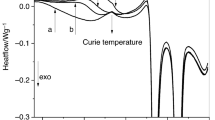Abstract
In compliance with the hypothesis that the crystal structure stability increases with a decrease in the degrees of freedom of the constituent atoms, we propose quantitative criteria for structures: the ratio between the amount of the degrees of freedom of atoms to their number in a primitive cell (S) and the fundamental volume (V*)–the quotient of the cell volume (asymmetric unit) and the order of the symmetry group (M) that is the general position multiplicity. The crystallographic analysis of diamond and spinel structure types and their comparative analysis with stability and packing criteria are performed. The study uses the findings from the analysis of abundant less symmetrical tourmaline and apatite structure types which confirm the existence of standard frameworks–symmetrical spatial configurations of atomic sites that can be taken by atoms of various types.
Similar content being viewed by others
References
A. F. Wells, Structural Inorganic Chemistry, 5 ed., Clarendon Press, Oxford (1986).
D. Topa, E. Makovicky, and G. Ilinca, Can. Mineral., 50, No. 2, 295–312 (2012).
S. V. Borisov, S. A. Magarill, and N. V. Pervukhina, J. Struct. Chem., 58, No. 8, 1691–1698 (2017).
S. V. Borisov, J. Struct. Chem., 33, No. 6, 871–877(1992).
S. V. Borisov, S. A. Magarill, and N. V. Pervukhina, Russ. Chem. Rev., 84, No. 6, 393–421 (2015).
S. V. Borisov, J. Struct. Chem., 36, No. 6, 1061/1062 (1995).
S. V. Borisov, S. A. Magarill, and N. V. Pervukhina, Crystallogr. Rep., 56, No. 6, 1001–1006 (2011).
I. Yamanaka and S. Morimoto, Acta Crystallogr. B, 52, 232–238 (1996).
S. A. Gromilov, E. A. Bykova, and S. V. Borisov, Crystallogr. Rep., 56, No. 6, 1013–1018 (2011).
N. G. Zorina and S. S. Kvitka, Kristallografiya, 13, No. 4, 599/600 (1969).
D. J. Henry, M. Novák, F. C. Hawthorne, et al., Am. Mineral., 96, 895–913 (2011).
P. Trucano and R. Chen, Nature, 258, 136/137 (1975).
Author information
Authors and Affiliations
Corresponding author
Additional information
Original Russian Text © 2018 S. V. Borisov, N. V. Pervukhina, S. A. Magarill.
Translated from Zhurnal Strukturnoi Khimii, Vol. 59, No. 1, pp. 118–123, January–February, 2018.
Rights and permissions
About this article
Cite this article
Borisov, S.V., Pervukhina, N.V. & Magarill, S.A. Crystallographic Basis for the Stability of Abundant (Popular) Structure Types. J Struct Chem 59, 114–119 (2018). https://doi.org/10.1134/S002247661801016X
Received:
Published:
Issue Date:
DOI: https://doi.org/10.1134/S002247661801016X




